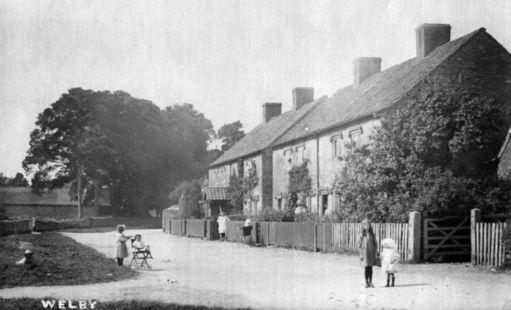
Picture above shows Long Row, Main Street Welby
Welby used to hold an annual Parish Feast where the men and boys of Welby gathered for the feast.
According to A Dictionary of British Place Names, Welby is a "farmstead or village by a spring or stream", combining the Old English "wella" for a stream, with Old Scandinavian "by" for a "farmstead, village or settlement".
Welby is recorded in the 1086 Domesday account as "Wellebi", within two manors in the Threo Hundreds of Kesteven. The first manor held 57 households, 7 villagers, 4 smallholders, 37 freemen, a priest, a church, and a meadow of 160 acres (0.6 km2) and woodland of 150 acres (0.6 km2). In 1066 Queen Edith was Lord of the Manor, this transferred to William I in 1086, who also became Tenant-in-chief.
The second Domesday entry shows a manor with 3 villagers, 5 freemen and 4 ploughlands, with a meadow 53 acres (0.2 km2) and woodland of 80 acres (0.3 km2), with the 1066 Lord being Aethelstan son of Godram. In 1086 Lordship was transferred to Ranulf, with Guy of Craon becoming Tenant-in-chief.
Welby Grade I listed Anglican parish church is dedicated to St Bartholomew. The church originates from the 13th century and is mainly Early English but with a Perpendicular clerestory and porch In 1873 the north aisle was extended and the chancel rebuilt by J. H. Hakewill, who matched the Early English style Within the porch is a 14th-century stone tomb cover with relief depictions of a woman's head and shoulders, within a quatrefoil recess, and a shrouded baby. It was originally sited in the graveyard.
The former rectory, also a listed building, was designed by Grantham architect Cornelius Sherborne. In 1885 Kelly's Directory reported a Wesleyan chapel, built in 1866, and a school and four almshouses founded in 1780 by William Welby; a further school for 70 pupils was built in 1869. The main crops grown were wheat, barley, oats and turnips, within a parish area of 2,661 acres (11 km2). The 1881 population was 390. Lord of the Manor and owner of parish land was Sir William Earle Welby-Gregory DL, JP, of Denton Hall. Kellys also noted two public houses, the Red Lion and Waggon and Horses, 12 farmers, 4 graziers, a butcher, shoemaker, shopkeeper, carrier, coal dealer, wheelwright, beer retailer, harness maker and a blacksmith.
Considering that in 1881 the population was listed as being 390 residents, due to the changes in farming needs and the growth of other industries, the current population (2020) is believed to be 176.
